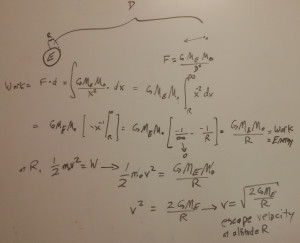Escape Velocity is commonly described as the minimum speed an object must reach to escape the Earth (or other celestial body) into space. But this definition is ambiguous and can be misleading.
You can escape the Earth at walking speed, if you could walk straight up; you don’t need anywhere near escape velocity. Imagine a rocket launch; in the first few seconds just as it starts to move, it’s going up at walking speed. Theoretically, it could throttle back the engines to maintain that slight upward speed all the way into space, so long as it didn’t run out of fuel or become unstable. A space elevator could also leave Earth at mundane speeds.
The key to this ambiguity is escape velocity applies to a free body, an object that is passively moving according to the laws of physics, having no thrust of its own. In other words, if a rocket achieves escape velocity, it could at that point turn off its engines and it would still escape the Earth. Intuitively it seems the higher the altitude, the slower the escape velocity. This turns out to be correct.
Escape velocity is easy to understand and derive mathematically with some creative thinking. Imagine 2 objects in space (a big one and a much smaller one, like the Earth and a stone) surrounded by vacuum, no other objects. So there is no friction and no other bodies exerting gravitational pull. Suppose the stone is at rest relative to the Earth and almost infinitely far away. The gravitational pull is effectively zero. Imagine the stone precariously balanced just on the outer rim of Earth’s gravity well. Then you nudge the stone just a smidge toward the Earth, so it crosses that rim and the Earth starts pulling on it (and vice versa). It starts out slow, but accelerates toward the Earth incrementally faster and faster.
Eventually, when the stone reaches the Earth it will be moving very fast. Escape velocity is the speed it is going just before it smashes into the Earth. Or if it misses the Earth, it’s the speed at its point of closest approach. More correctly and completely, the stone is always traveling at escape velocity at every moment along its path. The escape velocity for that distance from the Earth, is the speed at which the stone is moving when it’s that far away.
Note: the bold face statement above is the nut of this explanation. When you grok its fullness, you grok the fullness of escape velocity.
That’s because of conservation of energy. When the stone was at the rim of Earth’s gravity well, it had a lot of potential energy. At the point of closest approach, all that potential energy has been converted into kinetic energy. Assuming no atmosphere, no losses, the two energies are equal. So as the stone speeds past the Earth, slowing down due to the same gravitational pull that sucked it in, that kinetic energy is converted back into potential energy. So it must reach the exact same distance away when it peters out and eventually stops.
The direction of motion is irrelevant to escape velocity. Normally this seems counterintuitive, but understanding escape velocity with our theoretical example, you can easily see why direction doesn’t matter. At that point of closest approach, it doesn’t matter what direction the stone is moving relative to the Earth. It could be nearly straight up (can’t be exactly straight up, or it wouldn’t have missed), or nearly horizontal. If it’s going horizontal, it has to travel further to escape, but being horizontal, gravity isn’t pulling it as hard. These conflicting factors are equal and cancel each other. All that matters is the altitude (distance of closest approach), because the speed depends only how much energy it’s gained from Earth’s gravity field.
If, at that point of closest approach, the stone were moving any slower, then it would have less kinetic energy, and it will not go as far away. That means it won’t make it to the rim of Earth’s gravity well, so it will still be inside the well, reverse direction and eventually come back to Earth. So escape velocity is the minimum speed a free body can have, and escape the Earth.
Of course, in the real world direction does matter. The Earth has an atmosphere that creates a lot of friction and energy loss at high speeds. If you go straight up, you’re in the atmosphere for a shorter time, less energy loss. If you go horizontal, you’re in the atmosphere longer and will lose more energy.
Here is the mathematical derivation:
